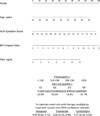Baseline characteristics predict risk of progression and response to combined medical therapy for benign prostatic hyperplasia (BPH)
- PMID: 24825577
- PMCID: PMC4231026
- DOI: 10.1111/bju.12802
Baseline characteristics predict risk of progression and response to combined medical therapy for benign prostatic hyperplasia (BPH)
Abstract
Objective: To better risk stratify patients, using baseline characteristics, to help optimise decision-making for men with moderate-to-severe lower urinary tract symptoms (LUTS) secondary to benign prostatic hyperplasia (BPH) through a secondary analysis of the Medical Therapy of Prostatic Symptoms (MTOPS) trial.
Patients and methods: After review of the literature, we identified potential baseline risk factors for BPH progression. Using bivariate tests in a secondary analysis of MTOPS data, we determined which variables retained prognostic significance. We then used these factors in Cox proportional hazard modelling to: i) more comprehensively risk stratify the study population based on pre-treatment parameters and ii) to determine which risk strata stood to benefit most from medical intervention.
Results: In all, 3047 men were followed in MTOPS for a mean of 4.5 years. We found varying risks of progression across quartiles. Baseline BPH Impact Index score, post-void residual urine volume, serum prostate-specific antigen (PSA) level, age, American Urological Association Symptom Index score, and maximum urinary flow rate were found to significantly correlate with overall BPH progression in multivariable analysis.
Conclusions: Using baseline factors permits estimation of individual patient risk for clinical progression and the benefits of medical therapy. A novel clinical decision tool based on these analyses will allow clinicians to weigh patient-specific benefits against possible risks of adverse effects for a given patient.
Keywords: benign prostatic hyperplasia (BPH); lower urinary tract symptoms (LUTS); risk factors.
© 2014 The Authors. BJU International © 2014 BJU International.
Conflict of interest statement
None of the four authors have any conflicts of interest.
Figures



Similar articles
-
Influence of baseline variables on changes in International Prostate Symptom Score after combined therapy with dutasteride plus tamsulosin or either monotherapy in patients with benign prostatic hyperplasia and lower urinary tract symptoms: 4-year results of the CombAT study.BJU Int. 2014 Apr;113(4):623-35. doi: 10.1111/bju.12500. Epub 2014 Jan 9. BJU Int. 2014. PMID: 24127818 Clinical Trial.
-
Progression, risk factors and subsequent medical management of symptomatic benign prostatic hyperplasia.Arch Ital Urol Androl. 2009 Mar;81(1):1-8. Arch Ital Urol Androl. 2009. PMID: 19499750 Review.
-
Clinical outcomes after combined therapy with dutasteride plus tamsulosin or either monotherapy in men with benign prostatic hyperplasia (BPH) by baseline characteristics: 4-year results from the randomized, double-blind Combination of Avodart and Tamsulosin (CombAT) trial.BJU Int. 2011 Mar;107(6):946-54. doi: 10.1111/j.1464-410X.2011.10124.x. Epub 2011 Feb 18. BJU Int. 2011. PMID: 21332630 Clinical Trial.
-
Clinical progression, acute urinary retention, prostate-related surgeries, and costs in patients with benign prostatic hyperplasia taking early versus delayed combination 5α-reductase inhibitor therapy and α-blocker therapy: a retrospective analysis.Clin Ther. 2013 May;35(5):624-33. doi: 10.1016/j.clinthera.2013.03.010. Epub 2013 Apr 12. Clin Ther. 2013. PMID: 23583026
-
Monotherapy versus combination drug therapy for the treatment of benign prostatic hyperplasia.Am J Geriatr Pharmacother. 2005 Jun;3(2):103-14. doi: 10.1016/s1543-5946(05)00031-0. Am J Geriatr Pharmacother. 2005. PMID: 16129387 Review.
Cited by
-
Convective radiofrequency water vapour thermal therapy for lower urinary tract symptoms in men with benign prostatic hyperplasia.Cochrane Database Syst Rev. 2020 Mar 25;3(3):CD013251. doi: 10.1002/14651858.CD013251.pub2. Cochrane Database Syst Rev. 2020. PMID: 32212174 Free PMC article.
-
Minimally invasive treatments for lower urinary tract symptoms in men with benign prostatic hyperplasia: a network meta-analysis.Cochrane Database Syst Rev. 2021 Jul 15;7(7):CD013656. doi: 10.1002/14651858.CD013656.pub2. Cochrane Database Syst Rev. 2021. PMID: 34693990 Free PMC article.
-
Prostatic urethral lift for the treatment of lower urinary tract symptoms in men with benign prostatic hyperplasia.Cochrane Database Syst Rev. 2019 May 25;5(5):CD012832. doi: 10.1002/14651858.CD012832.pub2. Cochrane Database Syst Rev. 2019. PMID: 31128077 Free PMC article.
-
Risk and treatment effect heterogeneity: re-analysis of individual participant data from 32 large clinical trials.Int J Epidemiol. 2016 Dec 1;45(6):2075-2088. doi: 10.1093/ije/dyw118. Int J Epidemiol. 2016. PMID: 27375287 Free PMC article.
-
BPH: Why Do Patients Fail Medical Therapy?Curr Urol Rep. 2019 Jun 6;20(7):40. doi: 10.1007/s11934-019-0899-z. Curr Urol Rep. 2019. PMID: 31168725 Review.
References
-
- Flanigan RC, Reda DJ, Wasson JH, et al. 5-year outcome of surgical resection and watchful waiting for men with moderately symptomatic benign prostatic hyperplasia: a Department of Veterans Affairs cooperative study. J Urol. 1998;160(1):12–16. discussion 16-17. - PubMed
-
- Jacobsen SJ, Girman CJ, Lieber MM. Natural history of benign prostatic hyperplasia. Urology. 2001;58(6 Suppl 1):5–16. discussion 16. - PubMed
-
- Martin S, Lange K, Haren MT, et al. Risk factors for progression or improvement of lower urinary tract symptoms in a prospective cohort of men. J Urol. 2014;191(1):130–137. - PubMed
-
- Roehrborn CG. BPH progression: concept and key learning from MTOPS, ALTESS, COMBAT, and ALF-ONE. BJU Int. 2008;101(Suppl 3):17–21. - PubMed
Publication types
MeSH terms
Substances
Grants and funding
LinkOut - more resources
Full Text Sources
Other Literature Sources
Medical
Research Materials
Miscellaneous

